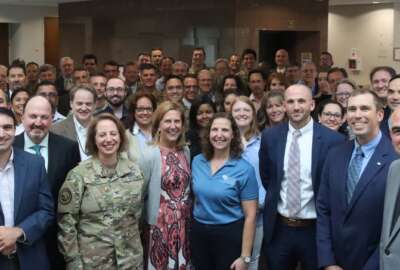Pentagon to build unmanned systems to compete with China
With a new initiative to build unmanned systems, the Pentagon wants to scale up fast with smaller, cheaper design.
The next big initiative the Defense Department plans to develop in its technology race with China will focus on relatively disposable, quickly produced unmanned systems. DoD wants the program, called “Replicator,” to move from development to operational capability in 18-20 months.
The program will stay in the spotlight as it will be supervised directly by Deputy Secretary of Defense Kathleen Hicks along with the chairman of the Joint Chiefs of Staff.
“We’re going to create a new state of the art — just as America has done before — leveraging attritable autonomous systems in all domains, which are less expensive, put fewer people in the line of fire and can be changed, updated or improved with substantially shorter lead times,” Hicks said to a packed house at an NDIA emerging technologies for defense conference Monday.
The budget for the multi-pronged initiative will start with a relatively modest “few hundred million dollars,” a DoD spokesperson said in response to an emailed question from Federal News Network. That money will come from a “variety of sources including reprogramming initiatives,” he said.
Hicks did not lay out specifics for what kind of unmanned systems the initiative will involve but said the Pentagon will work with combatant commands (COCOMS) to identify priorities.
“We are going to be cagey in terms of what we want to share, particularly with the Peoples Republic of China ,and we’re going to work very closely with Adm. John Aquilino, commander of the Indo-Pacific command and our other COCOMs on what some of the most ripe operational challenges are — where the technology is in the right place,” Hicks said.
Aquilino said his command needed the type of technological innovation Hicks promised with Replicator.
“All of my geographic combatant commander brothers and sisters need that same capability but we need to accelerate it. We need to stay in front of any adversary. We can talk about a couple of separate programs that we have put in place. The deputy’s articulation of Replicator falls right into the weapons pile,” he said.
Hicks said Replicator is meant to overcome China’s biggest advantages — its large population and its massive buildup of ships, missiles and other weapons. The DoD response will be a large build-up of lower-cost, quick-to-produce systems.
“Replicator will galvanize progress in the slow shift of military innovation to leverage platforms that are small, smart, cheap, and many,” Hicks said.
The concept of building an arsenal of relatively cheap “attritable” or somewhat disposable weapons systems gained traction over the last year. In March, The Space Development Agency announced the launch of a series of low-earth orbit transport satellites that they were able to buy commercially and move through the acquisition process in just two years. The agency plans several more launches of the satellites over the next two years.
Similar programs are in the works with the Defense Innovation Unit (DIU), and other research and development initiatives across DoD.
Hick said the Pentagon put together a deputies’ innovation steering group (DISG) at the beginning of the current administration which allows the office of the undersecretary of Defense for research and engineering to regularly meet with the Pentagon’s chief technology officers.
“DISG will be the driving engine for Replicator, we also created a body that will feed to Doug Beck, director of DIU, who is a direct report and now will lead and that will help us drive Replicator in that way,” Hicks said.
Copyright © 2024 Federal News Network. All rights reserved. This website is not intended for users located within the European Economic Area.
Alexandra Lohr, a former staff member, covered the Defense Department for Federal News Network until September 2023.







